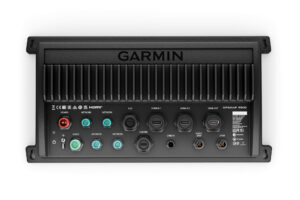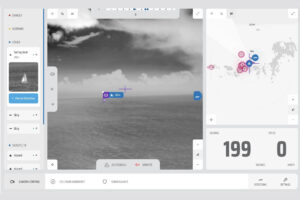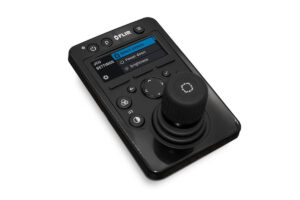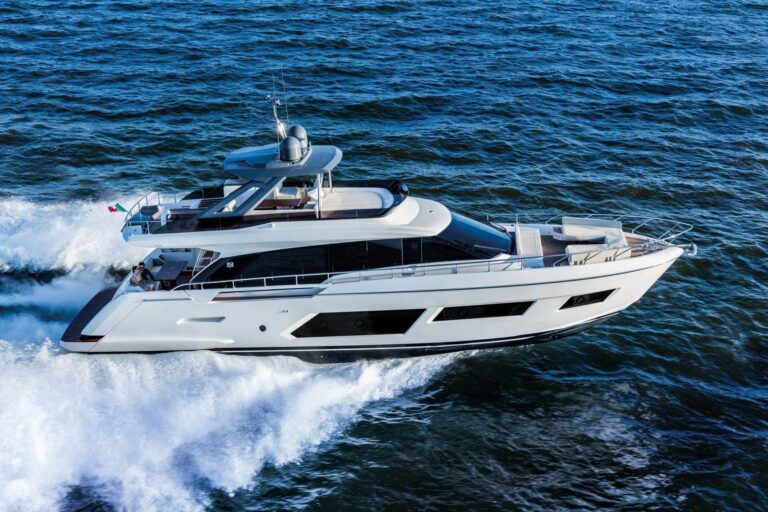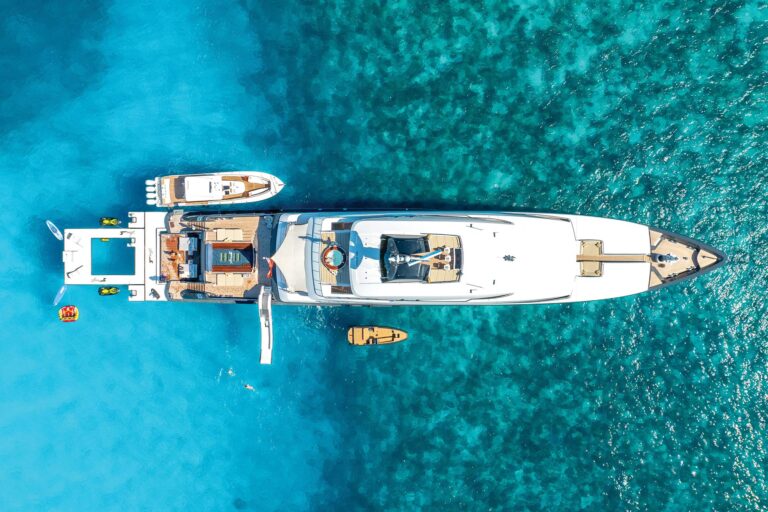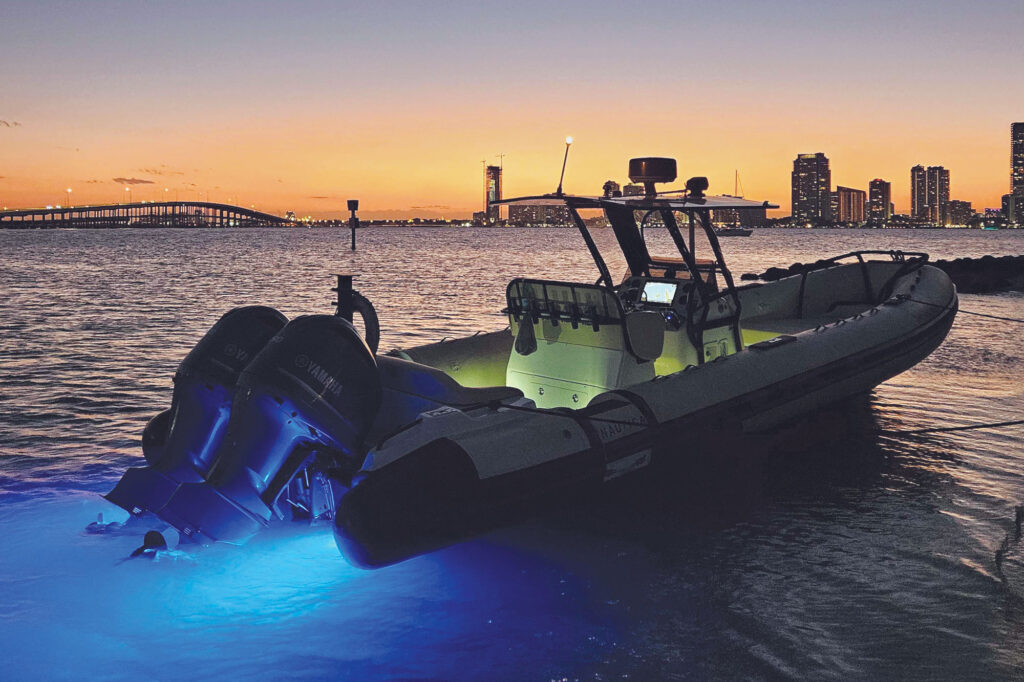
Boat-show season is the time when new-product announcements drop faster than daylight hours. This is great news for anyone looking to upgrade a boat’s electronics, and it’s also a chance to see all the fascinating ideas that have been percolating in companies’ R&D departments.
As you’re touring the docks and tents, keep an eye out for these products, which are all worth a closer look.
Fusion
While achieving playlist consensus can be tricky, all ears can agree that high-quality speakers outperform the low-end alternatives. Fusion’s Apollo speakers ($550 to $800) and subwoofers ($450 to $950) use redesigned motors and composite materials for everyone’s listening pleasure at higher volumes. Embedded dual-hue LED lighting, hexagonal-shaped tweeters and interchangeable grills enhance the onboard aesthetics. The coaxial speakers come in three sizes—6.5, 7.7 and 8.8 inches—and the subwoofers are available in 10- and 12-inch models. Apollo speakers and subwoofers have IP66/IP67 environmental ratings as well as marinized connectors, and are optimized to work with Fusion-built stereos.
Garmin
Seeing is believing, and Garmin’s GC 255 Flush Mount Camera makes it easier to believe that an approach to the dock will be successful. The GC 255 ($1,000) comes bundled in a stainless-steel body and delivers up to 1080p high-resolution imagery across a 160-by-90-degree field of view. It can present bird’s-eye, fish-eye or standard views, along with vessel-specific distance markers and customizable guidance lines that help to defang docking and close-quarters maneuvers. The GC 255 has an IPX7 rating, weighs 22.9 ounces, measures 3.2-by-3.2-by-3.3 inches, and has a plug-and-play setup with compatible Garmin-built multifunction displays.
JL Audio
This brand arrived at the fall shows with two new options for generating good times afloat. The MM55 ($400) provides full stereo control via its eight hard buttons, volume-control knob and 2.8-inch color screen, while the white-box MM55-HR ($350) networks with a compatible multifunction display or JL Audio-built controller for its user interface to provide a clean-looking helm. Both stereos support three audio zones, each with dedicated subwoofer outputs and independent or unified volume controls. They also sport built-in 100-watt amplifiers and digital AM/FM tuners. Additionally, both stereos have Bluetooth, USB 2.0 and NMEA 2000 connectivity, and come with auxiliary inputs for connecting external analog devices.
Lumitec
Visibility is paramount for safe anchoring and nocturnal operations. Lumitec’s Contour Masthead Combo Light is designed to ensure that a vessel can be seen from at least 3 nautical miles. The slim, lightweight light is available with an antenna mount ($250) or an Angler motorized base ($1,050) that raises and lowers the light as needed. Both versions have a 225-degree masthead light, a 360-degree anchor light and a 135-degree stern light that sit atop a 39-inch shaft. (Custom lengths are available.) Both are certified to US Coast Guard and National Marine Manufacturers Association standards.
Maretron
The WSV200 MConnect Web Server lets users take deep dives into their NMEA 2000 networks. Users can view graphically rich custom-built or pre-built user-interface screens for a wealth of vessel and systems data. Boaters also can access the MConnect Web Server ($600) while aboard using a compatible networked multifunction display, or from afar using embedded virtual private networks and any third-party device that has a web browser. Each MConnect can pair to two NMEA 2000 networks and more than 400 N2K data points. MConnect black boxes can also connect with digital-switching systems (third-party and Maretron-built systems), giving owners and three other users the ability to control and monitor systems and real-time information via a single platform. Additionally, each MConnect has an RJ45 Ethernet port, a USB 3.0 port and built-in Wi-Fi connectivity.
Sea.AI
Optical-based systems for collision avoidance are one of the most exciting instruments in years, but adding a full system can be redundant for boaters who already cruise with thermal-imaging cameras. Sea.AI’s Brain ($8,990) is a black-box system that processes imagery from a compatible thermal-imaging camera (one that conforms with the Open Network Video Interface Forum’s Profile S standards) and applies its embedded AI to detect nonwater objects in the video feed to provide warnings and alarms. Sea.AI’s Brain has three operating modes (collision avoidance, 360-degree surveillance and manual), and it’s compatible with Android, Apple iOS and Windows operating systems. Sea.AI’s Brain connects to a thermal-imaging camera via Ethernet, and it connects to a third-party device via Wi-Fi. Boaters use third-party software to display their camera’s video feed—plus Brain-detected targets and alarms—on their device.
Siren Marine
For years, connected-boat technology was mostly reserved for vessels with lengthy waterlines. This changed when Siren Marine introduced the Siren 3 for tenders and outboard-powered side rides. Each Siren 3 ($300) can network with six Siren-built wireless sensors (including bilge, high-water, entry and temperature sensors) via SirenWave, which is Siren Marine’s proprietary communications protocol. Additionally, each Siren 3 system can monitor one hard-wired battery, network with the boat’s NMEA 2000 backbone, and network with Yamaha’s Command Link network. Users can monitor all the information using a smartphone or smartwatch, and via the Siren Connected Boat app. Siren 3 is designed to be DIY or builder-installed, and it has a new internal antenna that makes it fit aboard smaller rides easier than its big brother, the Siren 3 Pro.
Tocaro Blue
Radars may be powerful sensors, but they can be challenging to read, especially for occasional users. Tocaro Blue’s Proteus Hub ($2,950) simplifies this task by connecting to a vessel’s NMEA 2000 data backbone and accessing networked radar and sensor data (depth, automatic identification system, heading and location information). Tocaro Blue’s ProteusCore software then applies AI machine learning to remove radar clutter and determine the nature of each target, such as buoys, markers and vessels. The system communicates with the radar to help optimize target detection, and it leverages the radar feed along with data from other networked sensors to predict the movement of its own vessel and all gathered targets over a 30-second horizon. This information is presented on a compatible multifunction display as a two-dimensional top-down map or a 3D view. Users can jump between views to find their best presentational fit.

